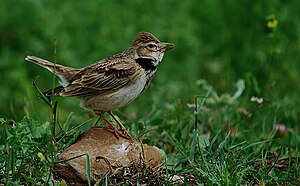Calender lark
| Calender lark | ||||||||||||
|---|---|---|---|---|---|---|---|---|---|---|---|---|

Calender Lark ( Melanocorypha calandra ) |
||||||||||||
| Systematics | ||||||||||||
|
||||||||||||
| Scientific name | ||||||||||||
| Melanocorypha calandra | ||||||||||||
| ( Linnaeus , 1766) |
The Calandra ( Melanocorypha calandra ) is a bird art , to the family of larks belongs (Alaudidae). It is a breeding bird of the Mediterranean and steppe zone from the southwest of the Palearctic to the Central Palearctic . In Central Europe it can occasionally be observed as a rare stray visitor .
features
The calender lark is 19 cm long and has a wingspan of around 40 centimeters. It has a large, thick beak , brownish pink feet, broad wings and a short, barely cut tail . On the upper side, depending on the geographical distribution, it is brown to light sand-colored, with light stripes over the eyes, throat and chest are creamy yellow, the latter with dark dashed lines, the other lower parts are white, with two large black spots on the sides of the neck. The wings are dark underneath and have a characteristic wide white rear edge. The tail feathers are brown-black, the outside of the tail white; the eye is brown, the beak brown above, yellowish below.
The singing performed while flying is similar to the skylark , but with a slower beat and many call-like tones and also contains imitations.
Occurrence
It inhabits arid steppe locations and structurally similar, man-made locations (pastures, arid grain fields) in southern Europe , northwest Africa, Turkey and Turkestan .
Eastern populations are migratory birds , western populations predominantly resident birds .
food
The food consists of comparatively large insects in summer and seeds in winter . In spring it also eats green shoots.
Breeding biology
The nest is on the ground in open ground, usually in a hollow, and consists of fairly coarse grass, small leaves, sprouts and roots and is lined with fine fibrous plant material. The clutch consists of three to six pale gray or yellowish white, olive or gray-brown spotted eggs. The one or two broods are incubated for about 16 days and the nestlings do not leave the nest fully fledged after about ten days.
supporting documents
literature
- Hans-Günther Bauer, Einhard Bezzel and Wolfgang Fiedler (eds.): The compendium of birds in Central Europe: Everything about biology, endangerment and protection. Volume 2: Passeriformes - Sperlingsvögel , Aula-Verlag Wiebelsheim, Wiesbaden 2005, ISBN 3-89104-648-0
- Urs N. Glutz von Blotzheim , Kurt M. Bauer: Alaudidae - Hirundinidae. Aula, Wiesbaden 1985, ISBN 3-923527-00-4 (Handbook of Birds of Central Europe, Vol. 10/1), pages 84-97.
Web links
- Melanocorypha calandra in the endangered Red List species the IUCN 2008. Posted by: BirdLife International, 2008. Accessed January 30 of 2009.
- Videos, photos and sound recordings of Melanocorypha calandra in the Internet Bird Collection
- Age and gender characteristics (PDF; 1.6 MB) by Javier Blasco-Zumeta and Gerd-Michael Heinze (English)
- Feathers of the calender lark
Single receipts
- ↑ Bauer et al., P. 124
